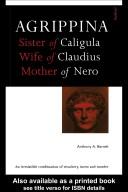| Listing 1 - 7 of 7 |
Sort by
|

ISBN: 0713468548 Year: 1996 Publisher: London : B.T. Batsford,
Abstract | Keywords | Export | Availability | Bookmark
 Loading...
Loading...Choose an application
- Reference Manager
- EndNote
- RefWorks (Direct export to RefWorks)
Empresses --- Impératrices --- Biography --- Biographie --- Agrippina, --- Nero, --- Family --- Rome --- History --- Histoire --- Impératrices --- Family.
Book
ISBN: 9780691208503 Year: 2020 Publisher: Princeton, NJ
Abstract | Keywords | Export | Availability | Bookmark
 Loading...
Loading...Choose an application
- Reference Manager
- EndNote
- RefWorks (Direct export to RefWorks)
Book
ISBN: 0713474033 Year: 1993 Publisher: London : B.T. Batsford,
Abstract | Keywords | Export | Availability | Bookmark
 Loading...
Loading...Choose an application
- Reference Manager
- EndNote
- RefWorks (Direct export to RefWorks)
Book
Abstract | Keywords | Export | Availability | Bookmark
 Loading...
Loading...Choose an application
- Reference Manager
- EndNote
- RefWorks (Direct export to RefWorks)
Book
ISBN: 9780198854579 0198854560 9780198854562 Year: 2023 Publisher: Oxford : Oxford University Press,
Abstract | Keywords | Export | Availability | Bookmark
 Loading...
Loading...Choose an application
- Reference Manager
- EndNote
- RefWorks (Direct export to RefWorks)
There can be few historical figures who have made such a powerful impact on the popular imagination as the Roman emperor Caligula (died AD 41). Yet an accurate reconstruction of his life and reign largely eludes us. This is paradoxical. The source material is plentiful, even lavish, by the standards of antiquity. The problem lies not so much in the quantity of evidence available, but in its quality. For our information we are obliged to draw on ancient accounts that can be colourful and wonderfully entertaining but have a flexible notion of historical truth and often seem to border on fiction. The consequence is that there is hardly a detail that the modern historian can present without deep reservations about its reliability.A biography of Caligula, in the regular modern sense of the word, is an insurmountable task, and can be at best be a summary personal interpretation by an individual historian of a mass of incoherent and often inconsistent material. Where does this leave the serious general reader? This book approaches Caligula from a quite different angle, by presenting the reader with the raw material of the ancient sources. It provides over 300 translated passages of texts, taken mainly from ancient writers, but also from coins and inscriptions. The translations are accompanied by extensive introductions and notes. These are tailored to the non-specialist, and intended to help such readers navigate material that is often contradictory, sometimes downright incredible, and helps to place events and institutions in their historical contexts. The colourful and exotic incidents are still here, but are presented in a context that will help the reader gain a more sophisticated understanding of how scholarstry to reconstruct events of the past. This approach allows the reader to tackle head-on the stark reality that what we read in our sources is not necessarily the truth.
Book
ISBN: 9780691156514 0691156514 1400881102 Year: 2016 Publisher: Lawrenceville Princeton University Press
Abstract | Keywords | Export | Availability | Bookmark
 Loading...
Loading...Choose an application
- Reference Manager
- EndNote
- RefWorks (Direct export to RefWorks)
Nero's reign (AD 54-68) witnessed some of the most memorable events in Roman history, such as the rebellion of Boudica and the first persecution of the Christians-not to mention Nero's murder of his mother, his tyranny and extravagance, and his suicide, which plunged the empire into civil war. The Emperor Nero gathers into a single collection the major sources for Nero's life and rule, providing students of Nero and ancient Rome with the most authoritative and accessible reader there is.The Emperor Nero features clear, contemporary translations of key literary sources along with translations and explanations of representative inscriptions and coins issued under Nero. The informative introduction situates the emperor's reign within the history of the Roman Empire, and the book's concise headnotes to chapters place the source material in historical and biographical context. Passages are accompanied by detailed notes and are organized around events, such as the Great Fire of Rome, or by topic, such as Nero's relationships with his wives. Complex events like the war with Parthia-split up among several chapters in Tacitus's Annals-are brought together in continuous narratives, making this the most comprehensible and user-friendly sourcebook on Nero available.Some images inside the book are unavailable due to digital copyright restrictions.
Geschiedbronnen. --- Nero, --- Néron, --- 54-68. --- Rome (Empire). --- Rome --- History
Book
ISBN: 9781400881109 Year: 2016 Publisher: Princeton, NJ
Abstract | Keywords | Export | Availability | Bookmark
 Loading...
Loading...Choose an application
- Reference Manager
- EndNote
- RefWorks (Direct export to RefWorks)
| Listing 1 - 7 of 7 |
Sort by
|

 Search
Search Feedback
Feedback About UniCat
About UniCat  Help
Help News
News